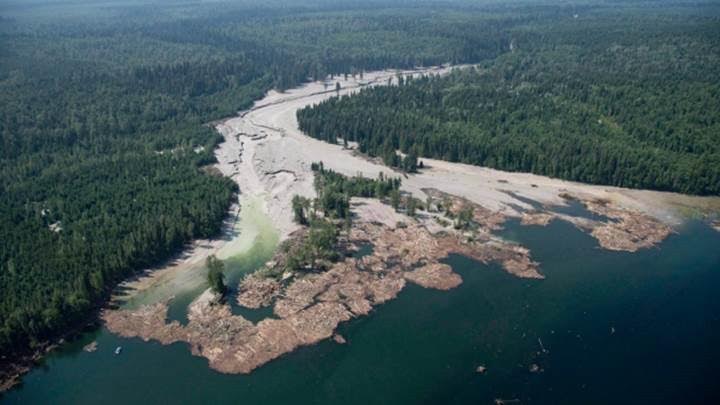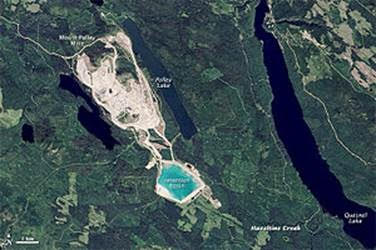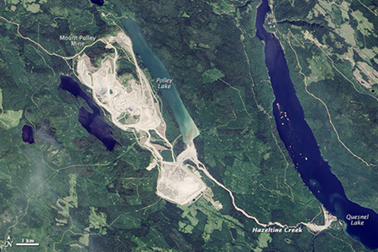The PolyMet Project and the Lethal Risks to the St Louis River Watershed and Lake Superior
ENVIRONMENT, 6 Feb 2017
Gary G. Kohls, MD | Duty to Warn – TRANSCEND Media Service
It’s an Acceptable Risk for Foreign Investors to Take but What about Us?
“ALL tailings “ponds” are a problem. If they don’t breach and spill massive amounts of toxic sludge into the environment like at Mount Polley, they leach that contamination slowly, poisoning the waters and lands around them.” — From: http://canadians.org/blog/update-mount-polley-mine-disaster-imperial-metals-and-government-focus-covering-instead.
Last year, Duluth News-Tribune published a Local News article with the title “EPA signals its support for final PolyMet review”.
The article ended with what I regard as an intentionally deceptive and woefully insufficient sentence: “Critics say the project is likely to taint downstream waters with acidic runoff”.
In a column for the Duluth Reader, which I wrote in response, I attempted to correct the notion that “acidic runoff” is the major reason for the widespread opposition to PolyMet’s proposed copper/nickel mining project (which is adjacent to the pristine Boundary Waters Canoe Area Wilderness). PolyMet, it should be mentioned, is a Penny Stock company from Canada and a total novice when it comes to operating copper/nickel mines. The company has never earned a penny producing a product. All their revenues have come from speculators and other investors that are hoping that the regulatory agencies will succumb to corporate and public pressure, that the mine will be built and that they can cash in on their investment.
<<<The Mount Polley Copper Mining Disaster of 2014>>>
On August 4, 2014, a mine at Mount Polley, British Columbia had its huge tailings pond dam (an earthen dam) suddenly burst, massively polluting downstream streams, rivers and lakes, not to mention underground aquifers which had already been polluted during the years before the catastrophe.
The millions of tons of toxic sludge flooded into tiny Hazeltine Creek and then into the pristine Quesnel Lake, which flows into the 800 mile long British Columbian Fraser River, a migratory Sockeye salmon-bearing river, that empties into the Georgia Strait and the Pacific Ocean at the city of Vancouver, B.C.
Typical of most government and industry responses to such catastrophic mining industry failures, Stephen Harper’s conservative government of Canada – not to mention the ruling Liberal Party government of British Columbia – tried to cover up the disaster. Hence, most North Americans on either side of the border (certainly us Minnesotans) were unaware of the event, thanks in part to our co-opted corporate-controlled media that failed to adequately report on it.
Immediately below are links to dramatic photos and videos that have been available to the US government and media agencies, but which were not reported on the evening news of either local or regional media outlets.
Imperial Metals Corporation of Vancouver, the owner of the mine, ahkowledged that they had been regularly dumping toxic metals into the slurry (aka “slime”) pond in the years leading up to the failure of the earthen dam. The following list of toxic minerals is taken from Environment Canada’s website at: (http://www.ec.gc.ca/inrp-npri/donnees-data/index.cfm?do=disposal_details&lang=En&opt_npri_id=0000005102&opt_report_year=2013.
Environment Canada reported that the metallic contaminants that had been dumped in the tailings pond included: Lead, Arsenic, Nickel, Zinc, Cadmium, Vanadium, Antimony, Manganese and Mercury.
Each of these 9 heavy metal contaminants are highly toxic to all life forms and have no safe levels in drinking water or in the serum or tissues of human or animal bodies. These contaminants, commonly found in hard rock mines, are also lethal to plant life, but only when they are ground up into fine powder form in the mineral extraction process.
It is important to recall that polluted aquifers can never be de-toxified by any known process.

The photo above was taken following the Mt Polley tailings pond failure. It pictures what was once the tiny, 6 foot wide Hazeltine Creek. Photo courtesy of Clayoquot Action, Tofino, BC (www.clayoquotaction.org)
Here is a selection of links to some of the videos of the Mount Polley tailings pond dam failure:
The first one is titled: ‘The Unlikely Truth’ – The Imperial Metals Environmental Disaster”:
httpv://www.youtube.com/watch?v=GfMolg5Ul_0
httpv://www.youtube.com/watch?v=SfanpPz8HeA
httpv://www.youtube.com/watch?v=xAItFxc8bME&feature=youtu.be
httpv://www.youtube.com/watch?v=vg3yd8GPSnA
And here is an important video of an experimental tailings dam breach that can happen to any earthen dam:
httpv://www.youtube.com/watch?v=bWEWVw7TGk4
“ALL tailings “ponds” are a problem. If they don’t breach and spill massive amounts of toxic sludge into the environment like at Mount Polley, they leach that contamination slowly, poisoning the waters and lands around them.”

The birds-eye view of the mouth of the tiny (normally about 6 feet wide) Hazeltine Creek (now 120-150 feet wide) as it enters into Quesnel Lake, the previously deepest, purest lake in British Columbia and a famous trout and salmon fishery; that is, until August 5, 2014, when 24,000,000 cubic meters of toxic water and sludge breached the Mt Polley mine’s tailings dam and exploded downstream. The tan material in the photo represents millions of floating dead trees that were swept away in the massive sludge flood.
Immediately below are satellite photos of the Mt Polley copper/gold mining facility’s before and after it suddenly dissolved and broke in 2014. Note the change in color of the tailings pond, the nearby lakes and the widening of the Hazeltine Creek that directed the toxic sludge into Quesnel Lake. The creek had been invisible to satellite photos until the flood.
All these photos depict what are considered the biggest environmental disasters in the histories of Canada and could, someday in the near or distant future, represent what could happen to Minnesota’s St. Louis River watershed, since highly toxic metal tailings/sludge/slurry/slime ponds have a substantial risk of failing, especially in the case of one of our planet’s increasingly common (seemingly annual) 100-year catastrophic floods, storms or downpours. These photos are posted at: https://en.wikipedia.org/wiki/Mount_Polley_mine_disaster#Imperial_Metals_history
A Final Thought
Northern Minnesotans, Native American Water Protectors ( like the heroes at Standing Rock), sportsmen, environmentalists, downstream businesses, wild rice harvesters, fish, game, birds and just plain working folks whose babies and other vulnerable beings with developing brains need non-toxic water to thrive or simply survive must understand that such relatively common catastrophes could destroy the aquifers in the BWCAW, Birch Lake, the Partridge River, the Embarrass River, the St. Louis River, the city of Duluth and ultimately, Lake Superior.
In the considered opinion of many ethical thinkers, any human with an ounce of morality would conclude that the risks of allowing amateur mining companies such as PolyMet and Twin Metals – and other similarly amoral, sociopathic and non-human corporations like Switzerland’s GlencoreXstrata or Chile’s Andofagasta are too great. (Glencore and Andofagasta are the two major multinational mining corporations that control PolyMet and Twin Metals.) The plans to open and operate sulfuric acid-producing copper mines in pristine watersheds that are just upstream and upwind from children and other living things should be shelved for the good of the planet. But somehow, the legislators who are often in bed with their corporate paymasters are quite willing to ignore the risks in favor of a few temporary jobs. The risks seem to be OK for conscienceless corporations and their investors, but they don’t live here.
States that surround the potentially poisoned Lake Superior and the other downstream great lakes should have a say in the issue. Bullying corporations, along with their co-opted friends in positions of power in state and national capitals are quite willing to risk permanent catastrophes such as Mt Polley.
They, being the sociopathic entities that they are, can’t be expected to act as ethical humans, especially when billions of dollars are involved.
___________________________________
Dr Kohls is a retired physician from Duluth, MN, USA. He writes a weekly column for the Duluth Reader, the area’s alternative newsweekly magazine. His columns deal with the dangers of American fascism, corporatism, militarism, racism, malnutrition, Big Pharma’s psychiatric drugging and over-vaccination regimens, and other movements that threaten the environment, health, democracy, civility and longevity of the populace. Many of his columns are archived at http://duluthreader.com/search?search_term=Duty+to+Warn&p=2; http://www.globalresearch.ca/authors?query=Gary+Kohls+articles&by=&p=&page_id= or at https://www.transcend.org/tms/search/?q=gary+kohls+articles
This article originally appeared on Transcend Media Service (TMS) on 6 Feb 2017.
Anticopyright: Editorials and articles originated on TMS may be freely reprinted, disseminated, translated and used as background material, provided an acknowledgement and link to the source, TMS: The PolyMet Project and the Lethal Risks to the St Louis River Watershed and Lake Superior, is included. Thank you.
If you enjoyed this article, please donate to TMS to join the growing list of TMS Supporters.

This work is licensed under a CC BY-NC 4.0 License.


